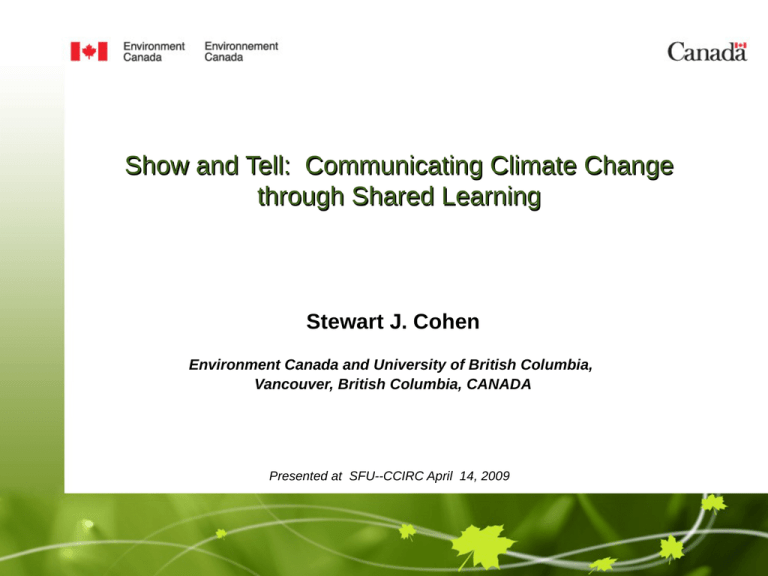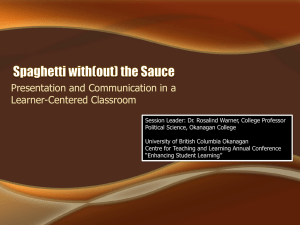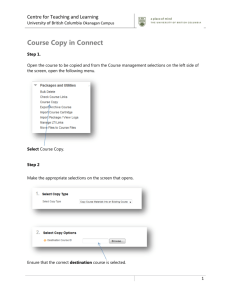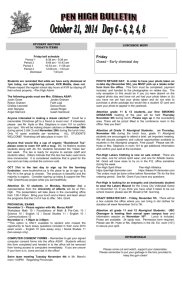Show and Tell: Communicating Climate Change through Shared Learning
advertisement

Show and Tell: Communicating Climate Change through Shared Learning Stewart J. Cohen Environment Canada and University of British Columbia, Vancouver, British Columbia, CANADA Presented at SFU--CCIRC April 14, 2009 Climate change information flow to stakeholders? Climate Information •Forecasts •Trends •Scenarios ou tr e ac h Stakeholder Interest •Regional development •Jobs •Liability •Quality of life Climate Change: The Medium is the Message Filter / medium Climate information •Forecasts •Trends •Scenarios delivery •Hydrograph •Crop model •Malaria risk model •Decision support tool Practitioner interest translation •Risk assessment •Design standards •Operating rules •Allocations ……translation from climate science to practitioner interest Climate change adaptation: linking research and practice?? • Choreography matters – A forward-looking first step • Context matters – Importance of extension agents • Flexibility in choices of tools – Mix of quantitative and qualitative approaches – Explicit insertion of climate change information into assessment of alternative response measures – An opportunity for team building, visualization and group-based modelling Example of Visualization: Snowpack/Mountain Recreation • Less precipitation falls as snow • Reduced spring snowpack • Shorter snow season • Earlier snowmelt Visualizations by Sheppard et al., UBC-CALP; Snow scenario generated by EC-PYR April 1st snowline elevation (m) Average April 1st Snowline 1600 Canadian General Circulation Model 2: A2 scenario 1200 800 400 0 1960 2000 2020 2050 Year 2100 Current Mean April 1st Snowline 2050s 2100 World Tier 11(A2) (A2) Mean Mean April April1st 1stSnowline Snowline(789m) (920m) (1074m) 2020s (759m) Capilano Reservoir Water Storage Peak Current summer conditions: drawdown: Average Lower summer lake Current conditions: spring level drawdown (439 Maximum ft.), (elevation more frequent 517 ft.) lake level (elevation 570 ft.) Building the science-policy bridge… • Dialogue with local • experts/practitioners as part of climate change adaptation assessment; beyond serving as an information source and outreach process Experts become extension agents for local adaptation Okanagan climate change study team visit to Penticton Dam, June 2002 Example of group-based modelling: Okanagan Basin water management & climate change study •Semi-arid •Area = 8200 km2 •Irrigated agriculture •Population: 2001 = 300,000 2006 = 340,000 Photos: upper left—Osoyoos and Osoyoos Lake (Denise Neilsen); right—irrigated agriculture, Summerland (Denise Neilsen); lower left--installation of intake at Penticton, Okanagan Lake (Bob Hrasko) Supply depends on • upland reservoirs • mainstem lakes • ground water • • • • • • • • • • Stewart Cohen (P.I.) – Adaptation & Impacts Research Division-EC, Institute for Resources Environment & Sustainability-UBC, Vancouver Denise Neilsen (P.I.2002-04), Scott Smith (P.I. 2002-04), Grace Frank, Walter Koch – Pacific Agricultural Research Centre-AAFC, Summerland Younes Alila, Wendy Merritt* – Forest Resources Management, UBC (*now at Australian National University) Mark Barton, Roger McNeill, Bill Taylor, Dave Hutchinson, Wendy Avis – Pacific & Yukon Region-EC Tina Neale, Philippa Shepherd, James Tansey, Jeff Carmichael, Stacy Langsdale, Rachel Welbourn, Natasha Schorb, Jennifer Ardiel, Glen Hearns, Alex Russell, Aviva Savelson, Sharon Bennett, Charlie Wilson – IRES & SCARP, UBC Brian Symonds, B.C. MOE, Penticton Bob Hrasko, Agua Consulting, Kelowna. Barbara Lence, Civil Engineering, UBC Craig Forster, U. Utah Allyson Beall, Washington State University Okanagan Study Teams (1999-2007) Study team (2002-04) & invited guests at team meeting, Summerland, June 2002 Thanks to Andrew Reeder, RDOS (formerly City of Summerland); Toby Pike, Water Supply Association; Greg Armour, OBWB; Patrick Deakin, Town of Oliver; Phil Epp, BC MOE; Jillian Tamblyn, Okanagan Nations Alliance; Leah Hartley, RDCO; Peter Waterman, BC Fruit Growers Assoc. & City of Summerland; & many others. Supported by grants from the CCAF/CCIAP (#A206, A463/433, A846), Natural Resources Canada, Ottawa. 6 5 4 3 2 1 0 1-Jan 1-Mar 1-May 1-Jul s20ca2 1-Sep s50ca2 1-Nov 5 4 3 2 1 0 1-Jan 1-Mar 1-May base90 1-Jul s20sa2 1-Sep s50sa2 5 4 3 2 1 0 1-Jan 3 2 1 0 1-Jan Simulated Discharge (cumecs) 1-Mar 1-May base90 1-Jul s20ha2 1-Sep s50ha2 1-Nov s80ha2 1-May 1-Jul s20sb2 1-Sep s50sb2 1-Nov s80sb2 Vaseaux Ck (above Dutton Ck) - HADLEY B2 7 0 1-Jan 1-Mar base90 7 1 s80cb2 4 8 2 s50cb2 1-Nov 5 Vaseaux Ck (above Dutton Ck) - HADLEY A2 3 s20cb2 1-Sep 6 8 4 1-Jul Vaseaux Ck (above Dutton Ck) - CSIRO B2 s80sa2 5 1-May 7 1-Nov 6 1-Mar base90 Vaseaux Ck (above Dutton Ck) - CSIRO A2 6 Vaseaux Ck (above Dutton Ck) - CGCM2 B2 6 s80ca2 Simulated Discharge (cumecs) Simulated Discharge (cumecs) 7 7 Simulated Discharge (cumecs) Simulated Discharge (cumecs) Vaseaux Ck (above Dutton Ck) - CGCM2 A2 base90 Simulated Discharge (cumecs) Streamflow Scenarios for Vaseux Creek (Merr 7 6 5 4 3 2 1 0 1-Jan 1-Mar 1-May base90 1-Jul s20hb2 1-Sep s50hb2 1-Nov s80hb2 Risks associated with water supply and demand in response to climate change (Neilsen et al., 2004, 2006) Maximum allowable demand – 2002 use Trout Creek supply/demand CGCM2-B2 2020s 10 2050s Crop water demand (m 2080s 8 6 4 2 0 0 50 100 150 3 200 6 x 10 ) 12 14 Historic 12 2020s 10 2050s 3 Historic Crop water demand (m 14 3 6 x 10 ) Trout Creek supply/demand HadCM3-A2 250 6 Annual flow (m x 10 ) Local defined drought – 30% average annual flow 2080s 8 6 4 2 0 0 50 100 150 3 200 6 Annual flow (m x 10 ) 250 Impact on Okanagan Water Management • Incorporation of climate change into Trepanier Landscape Unit Water Management Plan – Recommends demand management as first priority, along with supply augmentation, by 2050 if no climate change assumed, and by 2020 if climate change is assumed Okanagan Study Highlighted in IPCC 4AR Moving Beyond The Damage Report an opportunity for participatory integrated assessment (PIA) & decision support…. + Technical Info & Data = Experience Based Knowledge & Values Decision Support Model Preliminary sketch of decision model—OSWRM (Langsdale et al., 2006, 2007) Okanagan Surfacewater Supply Evaporating Tributaries Inflowing Human Use Diverting Precipitating on Lakes Agricultural Demand Flowing Out of Basin Residential Demand U.S. Border C & I Demand Input from some participants at Okanagan study model building workshop, April 2005 (Cohen & Neale, 2007) Upland agriculture supply / demand balance, high population growth; 2 = 1961-1990 base case; 3 = 2040-2069 : HadCM3-A2 NOTE: Supply Demand Balance = (supply – demand) / demand 2040-2069 : Upland agriculture supply / demand balance, high population growth; • = HadCM3-A2 • = HadCM3-A2 with unlimited supplemental use of Okanagan Lake NOTE: Assumes withdrawals from lake is unlimited 2040-2069 : Okanagan Lake stage, high population growth, unlimited supplement with Okanagan Lake, no DSM, max agr.-res. allocations, min conservation flows • = no climate change • = HadCM3-A2 • = CGCM2-B2 • = CSIROMk2-B2 NOTE: Assumes withdrawals not limited by shortages otherwise apparent when relying on tributaries 2040-2069 : Upland agriculture supply / demand balance, high population growth; • = 1961-1990 base case; • = HadCM3-A2 • = HadCM3-A2 with DSM and densification • = HadCM3-A2 with DSM and Okanagan Lake • = Hadley A2 with unlimited use of Okanagan Lake only 2040-2069 : Okanagan Lake stage, high population growth; • = 1961-1990 base case; • = HadCM3-A2 • = HadCM3-A2 with DSM (includes densification) • = HadCM3-A2 with DSM and Okanagan Lake • = HadCM3-A2 with Okanagan Lake only Okanagan Study Highlighted in Okanagan Sustainable Water Strategy • Sustainable water strategy • • • prepared for the Okanagan Basin Water Board [www.obwb.ca] planning for population growth, economic development, ecosystem needs, and climate change Broad portfolio, including DSM and direct withdrawal from mainstem lakes Architects of this strategy included local practitioners and decision makers who were participants in Okanagan climate change study 6 14 Historic 12 2020s 10 2050s 3 6 5 4 3 2 1 0 1-Jan Trout Creek supply/demand HadCM3-A2 Vaseaux Ck (above Dutton Ck) - CGCM2 A2 Crop water demand (m x 10 ) Simulated Discharge (cumecs) 7 1-Mar 1-May 1-Jul 1-Sep 1-Nov 2080s 8 6 4 2 0 0 50 100 150 3 base90 s20ca2 s50ca2 s80ca2 200 250 6 Annual flow (m x 10 ) From Trout Creek to the OSWS, 1999-2008 Participatory approach…link with practitioners (Cohen and Waddell, in press) Climate Information •Forecasts •Trends deli v h io n ac h ac ns l at ou tre Filter / Medium •Hydrograph •Crop Model •Malaria Risk Model •Decision Support Tool er y tr a •Scenarios ou tr e Practitioner Interest •Risk Assessment extension •Jobs •Design Standards •Allocations Stakeholder Interest •Regional development policy •Liability •Quality of life Conclusion • Opportunity for shared learning, • • exploring potential application of new kinds of tools, such as decision models and visualization Model building process can include dialogue with local knowledge holders (practitioners) Shared learning can lead to capacity building within local communities of practice For more information… • scohen@forestry.ubc.ca; stewart.cohen@ec.gc.ca • http://www.forestry.ubc.ca/aird






